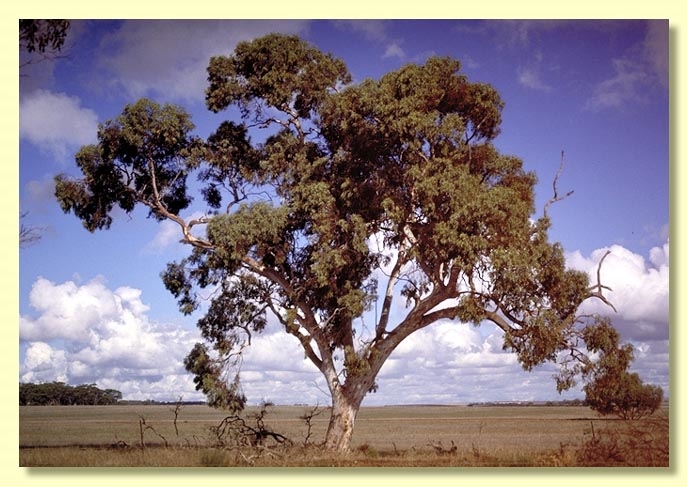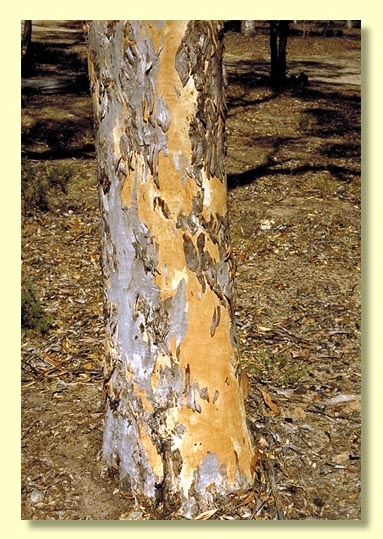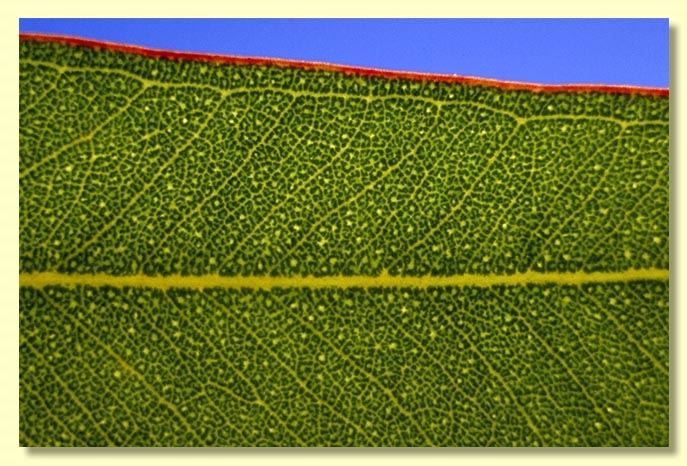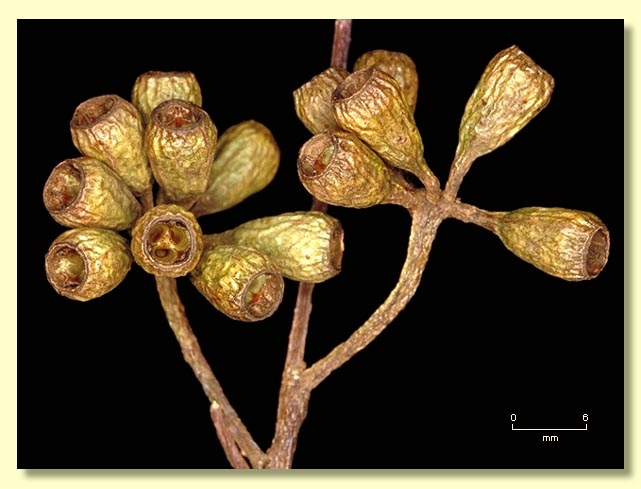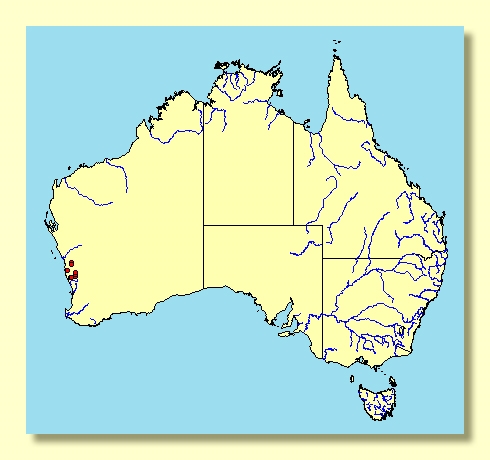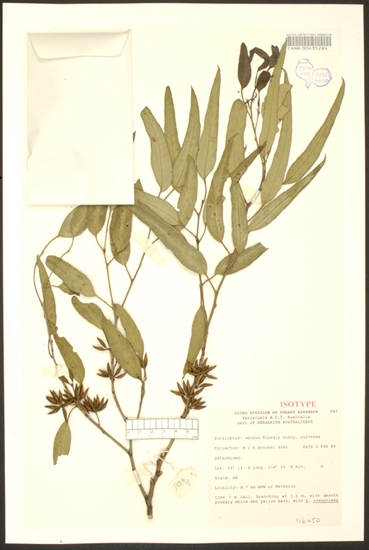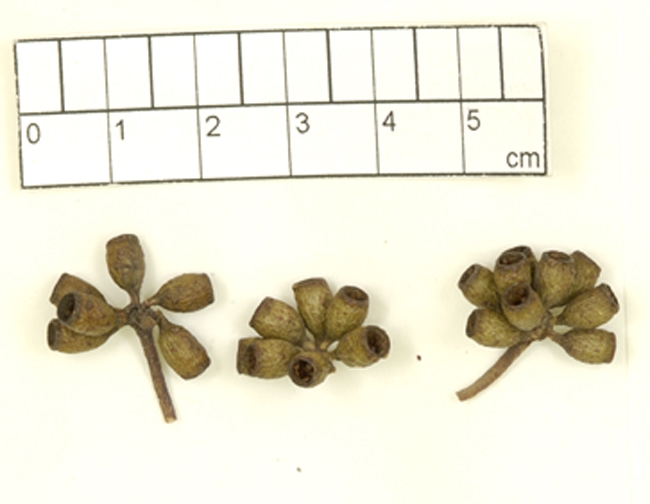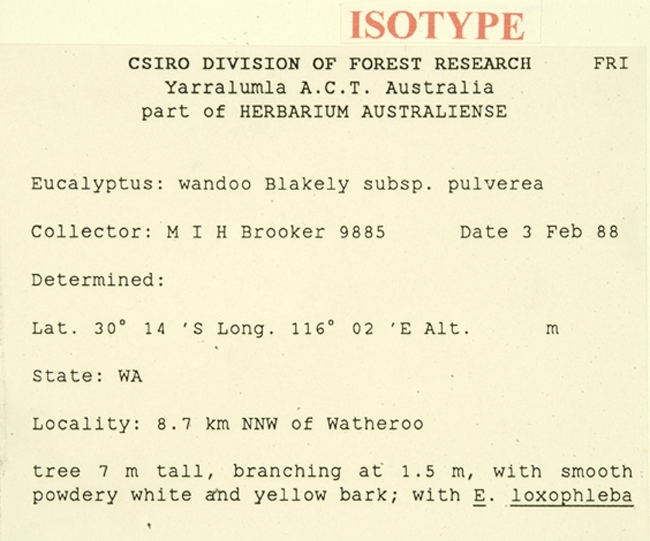Euclid - Online edition
Eucalyptus wandoo subsp. pulverea
Eucalyptus | Symphyomyrtus | Bisectae | Glandulosae | Levispermae | Cubiformes
Bark smooth throughout and powdery, fresh bark pale orange ageing to cream, white or pale grey.
Branchlets glaucous; pith glandular.
Juvenile growth (coppice or field seedlings to 50 cm): stems rounded or square in cross-section, glaucous; juvenile leaves always petiolate, alternate, ovate, broadly lanceolate or deltoid, to 4.5–13 cm long, 2.5–10 cm wide, glaucous.
Adult leaves alternate, petioles 1–2 cm long; blade lanceolate or slightly falcate, 7.5–12.5 cm long, 1–2.8 cm wide, base usually tapering, margin entire, apex pointed, concolorous, dull, rarely slightly glossy, grey-green to blue-grey, side-veins greater than 45° to midrib, reticulation moderate to dense, intramarginal vein remote from margin, oil glands mostly intersectional.
Inflorescence axillary unbranched, peduncles widening apically, 0.8–2 cm long, buds 9 to 15, pedicellate (pedicels 0.2–0.4 cm long). Mature buds fusiform but curved (0.8–1.4 cm long, 0.2–0.4 cm wide), scar present, operculum conical, to twice as long as hypanthium and equal to it at the join, a few outer stamens erect, most stamens variably deflexed, anthers oblong, dorsifixed, dehiscing by longitudinal slits, style long and straight, stigma more or less blunt, locules 3(4), the placentae each with 4 vertical rows of ovules. Flowers white.
Fruit pedicellate (pedicels 0.3 cm long), long-obconical to cylindrical, 0.6–0.9 cm long, 0.4–0.6 cm wide, disc descending usually vertically, valves 3(4), rim level or enclosed.
Seeds pale to mid-brown or straw-coloured, 0.7–1.3 mm long, cuboid to sub-spherical, surface smooth, hilum ventral/terminal.
Cultivated seedlings (measured at node 10): cotyledons Y-shaped (bisected); stem square to rounded in cross-section, waxy; leaves always petiolate, opposite for 2 or 3 nodes then alternate, deltoid to ovate or cordate, 5.5–11 cm long, 3–6 cm wide, dull, grey-green or slightly glaucous.
Flowering has been recorded in March.
The timber of E. wandoo is very hard, strong and durable and has been used extensively for sleepers, poles, flooring and many forms of heavy construction.
Eucalyptus wandoo is a species of small to medium-sized tree endemic to Western Australia, widespread in subcoastal plains and adjacent ranges from Morawa in the north through the Darling Range and south-east to Pallinup River east of the Stirling Range with an outlier in Twine Reserve east of Narambeen in the central wheatbelt. The bark of the mature tree is smooth and the adult leaves usualy dull, grey-green to blue-grey, although some specimens may have slightly glossy, green leaves, e.g. Twine Reserve. The bark of saplings is rough on the trunk. Juvenile leaves are deltoid to broadly lanceolate, to 10 cm wide.
Eucalyptus wandoo belongs to Eucalyptus subgenus Symphyomyrtus section Bisectae subsection Glandulosae because the cotyledons are bisected, buds have an operculum scar and the branchlets have oil glands in the pith. Within this subsection E. wandoo is one of a group of 14 species that form series Levispermae subseries Cubiformes, characterised by having smooth cuboid seed (not spherical), flattened peduncles that widen apically and buds that are narrowly fusiform with some stamens erect and others variably deflexed.
E. wandoo differs from its closest relatives, E. capillosa and E. nigrifunda, by having glabrous, not hairy-scabrid seedling and juvenile leaves. Coppice growth of all three species is usually plentiful in a stand of trees. In addition, the bark of E. wandoo is not as colourful as that of E. capillosa, and E. nigrifunda has some basal rough bark. Another species often referred to by the common name Powderbark Wandoo, E. accedens, belongs to another taxonomic series and can be distinguished by the more robust obovoid buds, very large deltoid juvenile leaves and seasonally orange smooth powdery bark.
There are two subspecies:
E. wandoo subsp. wandoo
This is the common form occurring from Gin Gin and Bindi Bindi southwards to the Hay River north of Denmark and easterly towards the Pallinup River area. Subsp. wandoo has smooth, white and non-powdery bark and the branchlets non-glaucous.
E. wandoo subsp. pulverea
The northern form occurring north from Cataby to Morawa. The bark is smooth, white and powdery and the branchlets are glaucous.
subsp. pulverea: Latin pulvereus, powdery, referring to the bark.

